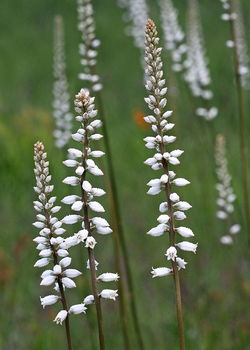True Unicorn root
From Wikiwel
(Redirected from Ague Grass)
Other Names : Aletris farinosa, Ague grass, ague-root, aletris, Aletris farinose, aletris farinseu, aloeroot, bettie grass, bitter grass, black-root, blazing star, colicroot, colic-root, colicweed, crow corn, devil's bit, diosgenin, gentrogenin, Liliaceae, mehlige Aletria , saponins, stargrass, star-root, starwort, unicorn root, white colic root.
The rootstock is used which should be collected in autumn.
See also : Aletris farinosa (Homeopathy)
Special Precautions of True Unicorn root
- Only use dried rootstock,in large doses the fresh root is somewhat narcotic, emetic and cathartic.
- Avoid in individuals with a known allergy or hypersensitivity to true unicorn root (Aletris farinose), its constituents, or members of the Liliaceae family.
- Side Effects are mainly gastrointestinal and include colic, diarrhea, nausea, and vomiting. Other possible side effects are dullness of senses, loss of balance, stupor, and vertigo (dizziness).
- Use cautiously in patients with hormone-sensitive cancers or conditions, as true unicorn root may affect hormonal activity.
- Use cautiously in pregnant women, as true unicorn root may have estrogenic activity and may counteract the effects of the hormone oxytocin, especially in the third trimester.
- Avoid in patients with a known allergy or hypersensitivity to true unicorn root, its constituents, or members of the Liliaceae family.
- Avoid in patients with inflammatory or infectious gastrointestinal conditions, as unicorn root may irritate the gastrointestinal tract.
- Pregnancy and Breastfeeding : True unicorn root may have estrogenic activity and may counteract the actions of the hormone oxytocin, especially in the third trimester.
- True unicorn root (Aletris farinosa L.) should not be confused with false unicorn root (Helonias luteum or Chamaelirium luteum). These herbs differ in chemical composition and claimed uses.
- True unicorn root may interact with antiulcer agents and estrogens.
Health Benefits and Uses of True Unicorn root
- Chemical Constituents: Alkaloids, Saponin, Diosgenin (anti-inflammatory and estrogenic), Vitamin E.
- Medicinal Properties: Anti-inflammatory, Bitter, Diuretic, Narcotic, Tonic, stomachic, and as such it is employed to promote the appetite and aid digestion, and in flatulence, colic, borborygmi, etc.
- The greatest value of unicorn root is its tonic influence on the female generative organs, proving to be of great use in treating cases of habitual miscarriages.
- It also promotes the appetite and is used in the treatment of diarrhoea, rheumatism and jaundice.
- The root is bitter, diuretic, narcotic and tonic.
- A decoction of the root is a bitter tonic and has been used for expelling flatulence and for various uterine disorders. It is used in the treatment of colic, though small doses, especially of the fresh root, can cause hypogastric colic. The root is harvested in late summer after flowering and dried for later use.
- Used in dyspeptic conditions.
- The root contains diosgenin, which has both anti-inflammatory and oestrogenic properties.
- A tea of the leaves has been used in the treatment of colic, stomach disorders, dysentery and bloody dysentery
- Used for “Female Complaints”, tones the uterus, anodyne, calms stomach, may have narcotic properties. Avoid use in pregnancy and when breastfeeding. No known interactions or contraindications, but may have estrogenic properties and should be avoided when estrogen is contra-indicated.
- History and Folklore : Keeps evil at bay when sprinkled around home or worn as sachet.
References
- Bloyer WE. Chamaelirium: Eclectic Materia Medica; Helonias, False unicorn root, Blazing star. Medical Herbalism: A Journal for the Clinical Practitioner 1898;10(3):18-20.
- Rajkumar R, Srivastava SK, Yadav MC., et al. Effect of a Homeopathic complex on oestrus induction and hormonal profile in anoestrus cows. Homeopathy 2006;95(3):131-135.
- Yarnell E, Abascal K, Greenfield RH, et al. Credentialing of practitioners of botanical medicine. Am J Med Qual 2002;17(1):15-20.
